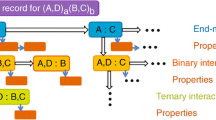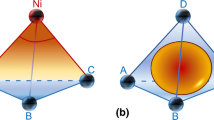Abstract
Databases concerning basic physical properties of materials, such as molar volume, density, thermal expansion coefficient, elastic constants, thermal conductivity, etc., are essential parts of the underlying knowledge for materials design. While thermodynamic databases provide chemical driving forces and phase equilibrium data, physical property databases provide essential physical parameters, such as volume, lattice constant, lattice misfit, elastic energy, interfacial energy, etc., for phase transformation and microstructure simulations. Combined with thermodynamic databases, physical property databases established on the basis of the calculation of phase diagram (CALPHAD) method can be used to calculate physical properties together with phase equilibria, phase fractions, phase compositions, and thermodynamic properties for multi-component and multi-phase material systems and for the constituent phases. In this paper, we will discuss in detail various volume models based on the CALPHAD method which are capable of describing experimental data in a wide range from cryogenic temperatures to melting points, from the atmospheric pressure to high pressures for pure substances as well as multi-component and multi-phase materials.



Similar content being viewed by others
References
Guillermet AF, Gustafson P, Hillert M (1985) The representation of thermodynamic properties at high pressures. J Phys Chem Solids 46:1427–1429
Jacobs MHG, Oonk HAJ (2000) A realistic equation of state for solids. The high-pressure and high-temperature thermodynamic properties of MgO. Calphad-Comput Coupling Ph Diagr Thermochem 24:133–147
Lu XG, Selleby M, Sundman B (2005) Implementation of a new model for pressure dependence of condensed phases in Thermo-Calc. Calphad-Comput Coupling Ph Diagr Thermochem 29:49–55
Brosh E, Makov G, Shneck RZ (2007) Application of CALPHAD to high pressures. Calphad-Comput Coupling Ph Diagr Thermochem 31:173–185
Hallstedt B, Dupin N, Hillert M et al (2007) Thermodynamic models for crystalline phases. Composition dependent models for volume, bulk modulus and thermal expansion. Calphad-Comput Coupling Ph Diagr Thermochem 31:28–37
Lu XG, Selleby M, Sundman B (2005) Assessments of molar volume and thermal expansion for selected bcc, fcc and hcp metallic elements. Calphad-Comput Coupling Ph Diagr Thermochem 29:68–89
Hallstedt B (2007) Molar volumes of Al, Li, Mg and Si. Calphad-Comput Coupling Ph Diagr Thermochem 31:292–302
Inden G (1976) Computer calculation of the free energy contributions due to chemical and/or magnetic ordering. In: Proceedings of CALPHAD V. Düsseldorf: Max-Planck-Institute, Düsseldorf, pp 1–13
Hillert M, Jarl M (1978) A model for alloying in ferromagnetic metals. Calphad-Comput Coupling Ph Diagr Thermochem 2:227–238
Guillermet AF (1987) Critical evaluation of the thermodynamic properties of cobalt. Int J Thermophys 8:481–510
Raub E, Engel M (1948) Alloys of zirconium with copper, silver and gold. Z Metallkd 39:172–177
Kudielka-Artner E, Argent BB (1962) Magnetic and other properties of some binary palladium alloys. Proc Phys Soc Lond 80:1143–1148
Catterall JA, Barker SM (1964) Resistivities and lattice parameters of some palladium and niobium alloys. In: Proceedings of the Plansee Seminar, pp 577–586
Norman M, Harris IR (1969) A study of some alpha palladium–scandium, -zirconium and -gadolinium alloys. J Less Common Met 18:333–345
Murnaghan FD (1944) The compressibility of media under extreme pressures. Proc Natl Acad Sci USA 30:244–247
Gustafson P (1986) An evaluation of the thermodynamic properties and the P, T phase diagram of carbon. Carbon 24:169–176
Guillermet AF, Gustafson P (1985) An assessment of the thermodynamic properties and the (p, T) phase diagram of iron. High Temp High Press 16:591–610
Guillermet AF (1985) Critical evaluation of the thermodynamic properties of molybdenum. Int J Thermophys 6:367–393
Gustafson P (1985) Evaluation of the thermodynamic properties of tungsten. Int J Thermophys 6:395–409
Grover R, Getting IC, Kennedy GC (1973) Simple compressibility relation for solids. Phys Rev B 7:567–571
Jacobs MHG, Oonk HAJ (2000) A new equation of state based on Grover, Getting and Kennedy’s empirical relation between volume and bulk modulus. The high-pressure thermodynamics of MgO. Phys Chem Chem Phys 2:2641–2646
Lu XG, Selleby M, Sundman B (2005) Theoretical modeling of molar volume and thermal expansion. Acta Mater 53:2259–2272
Lu XG, Selleby M, Sundman B (2007) Calculations of thermophysical properties of cubic carbides and nitrides using the Debye–Grüneisen model. Acta Mater 55:1215–1226
Lu XG, Chen Q (2009) A CALPHAD Helmholtz energy approach to calculate thermodynamic and thermophysical properties of fcc Cu. Philos Mag 89:2167–2194
Acknowledgments
This work was supported by the National Natural Science Foundation of China (51271106, 50934011). Mr. Weisen Zheng and Ms. Wei Liu from Shanghai University are acknowledged for their efforts during the preparation of the manuscript.
Author information
Authors and Affiliations
Corresponding author
Additional information
SPECIAL ISSUE: Materials Genome
About this article
Cite this article
He, YL., Lu, XG., Zhu, NQ. et al. CALPHAD modeling of molar volume. Chin. Sci. Bull. 59, 1646–1651 (2014). https://doi.org/10.1007/s11434-014-0218-5
Received:
Accepted:
Published:
Issue Date:
DOI: https://doi.org/10.1007/s11434-014-0218-5




